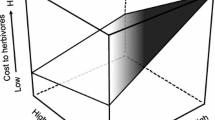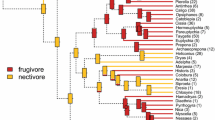Abstract
We investigated mechanisms that could lead to incorporation of unpalatable foods into the diet of a generalist grasshopper, Schistocerca americana: nutritional stress, habituation, learning, and attraction to novelty. The model system involved mesquite, a palatable but inferior food, and mulberry, an unpalatable but adequate food. Nutritional stress, due to prolonged intake of the inferior food, mesquite, did not increase the acceptability of mulberry. Habituation to the deterrent compounds in mulberry and associative learning of the nutritional benefits of mulberry also did not occur. However, mulberry became more acceptable after a day of restriction to a single food type other than mulberry, and even deterrent and nutritionally worthless alternatives such as filter paper became acceptable after a day on any one food type. A tendency to feed on novel food types may be a proximate mechanism for the incorporation of relatively unpalatable, but nutritionally valuable foods into the diet. Novelty and the apparent need for diversity of foods are discussed in the context of exploratory foraging behavior by generalist herbivores.
Similar content being viewed by others
REFERENCES
Bernays, E. A. (1993). Aversion learning and feeding. In Papaj, D. R., and Lewis, A. C. (eds.), Insect Learning, Chapman and Hall, New York, pp. 1–17.
Bernays, E. A. (1995). Effects of experience in host-plant selection. In Carde, R., and Bell, W. J. (eds.), Chemical Ecology, Chapman and Hall, New York.
Bernays, E. A., and Bright, K. L. (1993). Dietary mixing in grasshoppers: A review. Comp. Biochem. Physiol. A 104: 125–131.
Bernays, E. A., and Graham, M. (1988). On the evolution of host range in phytophagous insects. Ecology 69: 886–892.
Bernays, E. A., and Raubenheimer, D. (1991). Dietary mixing in grasshoppers: Changes in acceptability of different plant secondary compounds associated with low levels of dietary protein. J. Insect Behav. 4: 545–556.
Bernays, E. A., and Wrubel, R. (1985). Learning by grasshoppers: Association of colour/light intensity with food. Physiol. Entomol. 10: 359–369.
Bernays, E. A., Bright, K., Howard, J. J., Raubenheimer, D., and Champagne, D. (1992). Variety is the spice of life: Frequent switching between foods in the polyphagous grasshopper Taeniopoda eques. Anim. Behav. 44: 721–731.
Bernays, E. A., Bright, K., Angel, J., and Gonzalez, N. (1994). Dietary mixing in generalist grasshoppers: Tests of two hypotheses. Ecology 75: 1997–2006.
Capinera, J. L. (1993). Host-plant selection by Schistocerca americana (Orthoptera: Acrididae). Environ. Entomol. 22: 127–133.
Chambers, P., Sword, G., Angel, J., Behmer, S., and Bernays, E. A. (1996). Foraging by generalist grasshoppers: Two different strategies. Anim. Behav. 52: 155–165.
Champagne, D., and Bernays, E. A. (1991). Inadequate sterol profile as a basis of food aversion by a grasshopper. Physiol. Entomol. 16: 391–400.
Chapman, R. F., and Beerling, E. (1990). The pattern of feeding of first instar nymphs of Schistocerca americana. Physiol. Entomol. 15: 105–121.
Chapman, R. F., and Bernays, E. A. (1977). The chemical resistance of plants to insect attack. Scripta Varia 41: 603–643.
Chapman, R. F., and Sword, G. (1993). The importance of palpation in food selection by a polyphagous grasshopper (Orthoptera: Acrididae). J. Insect Behav. 6: 79–92.
Chapman, R. F., and Sword, G. (1994). The relationship between plant acceptability and suitability for survival and development of the polyphagous grasshopper, Schistocerca americana (Orthoptera, Acrididae). J. Insect Behav. 7: 411–431.
Clark, D. A. (1982). Foraging behavior of a vertebrate omnivore (Rattus rattus): Meal structure, sampling, and diet breadth. Ecology 63: 763–772.
Freeland, W. J., and Janzen, D. H. (1974). Strategies in herbivory by mammals: The role of secondary plant compounds. Am. Nat. 108: 269–289.
Galef, B. G. (1984). Reciprocal heuristics: A discussion of the relationship of the study of learned behaviour in laboratory and field. Learn. Motiv. 15: 479–493.
Geissler, T. G., and Rollo, C. D. (1997). The influence of nutritional history on the response to novel food by the cockroach, Periplaneta americana (L.). Anim. Behav. 35: 1905–1907.
Heinrich, B. (1979). Majoring and minoring by foraging bumblebees, Bombus vagans: An experimental analysis. Ecology 60: 245–255.
Illius, A. W., and Gordon, I. J. (1993). Diet selection in mammalian herbivores: Constraints and tactics. In Hughes, R. N. (ed.), Diet Selection, Blackwell, London, pp. 157–180.
Jermy, T., Bernays, E. A., and Szentesi, Á. (1982). The effect of repeated exposure to feeding deterrents on their acceptability to phytophagous insects. In Visser, J. H., and Minks, A. (eds.), Proceedings of the 5th International Symposium on Insect Plant Relationships, Pudoc, Wageningen, pp. 25–32.
Lee, J. C. (1990). Behavior of Polyphagous Insects: Diet Mixing, Ph.D. thesis, University of California, Berkeley.
Lee, J. C., and Bernays, E. A. (1988). Declining acceptability of a food plant for a polyphagous grasshopper Schistocerca americana: The role of food aversion learning. Physiol. Entomol. 13: 291–301.
Noldus, L. P. J. J. (1991). The Observer: A software system for collection and analysis of observational data. Behav. Res. Meth. Instrum. Comput. 23: 415–429.
Otte, D. (1975). Plant preference and plant succession: A consideration of evolution of plant preference in Schistocerca. Oecologia 18: 129–144.
Pennings, S. C., Nadeau, M., and Paul, V. J. (1993). Selectivity and growth of the generalist herbivore Dolabella auricularia feeding upon complementary resources. Ecology 74: 89–890.
Provenza, F. D. (1997). Acquired aversions as the basis for varied diets of ruminants foraging on rangelands. J. Anim. Sci. (in press).
Raubenheimer, D., and Bernays, E. A. (1993). Patterns of feeding in the polyphagous grasshopper Taeniopoda eques: A field study. Anim. Behav. 45: 153–167.
Rockwood, L. L. (1976). Plant selection and foraging patterns in two species of leaf-cutting ants (Atta). Ecology 57: 48–61.
Rolls, B. R., Van Duijvenvoorde, P. M., and Rowe, E. A. (1983). Variety in the diet enhances intake in a meal and contributes to the development of obesity in the rat. Psychol. Behav. 31: 21–27.
Rozin, P. (1976). The selection of foods by rats, humans and other animals. In Rosenblatt, J. S., Hinde, R. A., Shaw, E., and Beer, C. G. (eds.), Advanced in the Study of Behavior, Vol. 6, Academic Press, New York, pp. 21–76.
Seaman, J. W., Wall, S. C., Wise, S. E., and Jaeger, R. G. (1994). Caveat emptor: Rank transform methods and interaction. TREE 9: 261–263.
Simpson, S. J. (1982a). Patterns in feeding: A behavioural analysis using Locusta migratoria nymphs. Physiol. Entomol. 7: 325–336.
Simpson, S. J. (1982b). Changes in the efficiency of utilization of food throughout the fifth instar of Locusta migratoria. Entomol. Exp. Appl. 31: 265–275.
Simpson, S. J., and White, P. R. (1990). Associative learning and locust feeding: Evidence for a “learned hunger” for protein. Anim. Behav. 40: 506–513.
Stephens, D. W. (1987). On economically tracking a variable environment. Theor. Pop. Biol. 32: 15–25.
Stephens, D. W., and Krebs, J. R. (1986). Foraging Theory, Princeton University Press, Princeton, NJ.
Szentesi, Á., and Bernays, E. A. (1984). A study of behavioural habituation to a feeding deterrent in nymphs of Schistocerca gregarina. Physiol. Entomol. 9: 257–265.
Turpin, B., and Johnston, T. D. (1991). Paradoxical effects of experience with food size and flavor in golden hamsters, Mesocricetus auratus. Anim. Behav. 42: 103–110.
Wilson, D. S., Coleman, K., Clark, A. B., and Biederman, L. (1993). Shy-bold continuum in pumpkinseed sunfish (Lepomis gibbosus): An ecological study of a psychological trait. J. Comp. Psychol. 107: 250–260.
Woodhead, S. (1982). p-Hydroxybenzaldehyde in the surface wax of sorghum: Its importance in seedling resistance to acridids. Entomol. Exp. Appl. 31: 296–302.
Author information
Authors and Affiliations
Rights and permissions
About this article
Cite this article
Bernays, E.A., Augner, M. & Abbot, D.K. A Behavioral Mechanism for Incorporating an Unpalatable Food in the Diet of a Generalist Herbivore (Orthoptera: Acrididae). Journal of Insect Behavior 10, 841–858 (1997). https://doi.org/10.1023/B:JOIR.0000010417.24991.9e
Issue Date:
DOI: https://doi.org/10.1023/B:JOIR.0000010417.24991.9e




